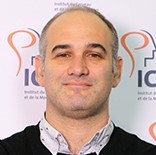
SITT Jacobo
Title: MD, PhD, DR2
Function: Team Leader, PI
Affiliated entities INSERM
Biography
A physician with a bachelor's degree in physics, he received multidisciplinary training by training me as a psychiatrist while simultaneously pursuing a doctorate in the physics of dynamic systems. This dual orientation has brought her into contact with the daily challenges of clinical practice. But, at the same time, to acquire advanced tools from mathematical modelling, non-linear dynamics, the science of complexity, information theory and data mining, which are essential to analyze and interpret biomedical issues. In November 2015, he was recruited by INSERM as a permanent independent researcher (CRCN, promoted to DR2 research director in 2019). His research plan focuses on testing the causal role of neural markers of consciousness, using different experimental models (brain injury, sleep and anesthesia), neuroimaging methods (M/EEG, sEEG, fMRI) and stimulation techniques (tES, auditory stimulation).
- Multivariate EEG analysis in disorders of consciousness: For the past decade, he has led a program to develop and validate new neurophysiological markers of consciousness in patients with brain injuries. More recently, they have integrated these markers into a public (and web-based, see demo.doc-eeg.net) pipeline that allows their implementation in any clinical centre.
- In this project, they studied how the functional connectivity dynamics of the brain change in different states of consciousness. They demonstrated that states of consciousness are associated with the emergence of long-range connections and anti-correlations between brain areas. These results have been validated in several species (human and non-human primates) and under different conditions of unconsciousness (anaesthesia and brain injury).
- Detection of consciousness from the body: In this line, he plans to study whether they can use the signals of the body (and their interaction with the brain) to determine the state of consciousness of DoC patients. The basis of this proposal is that although consciousness occurs in the brain, the brain also constantly modulates bodily activity (i.e. cardiac and respiratory function) and recent results in healthy participants showing that the cognitive process modulates these body signals. In this project, they extend these ideas to study consciousness in clinics. A key benefit of this new assessment framework is that brain-body interactions are traditionally explored using body signals that are readily available in any hospital. This new framework will allow the introduction of assessment tools in contexts where neuroimaging-based tools are currently difficult to implement.

